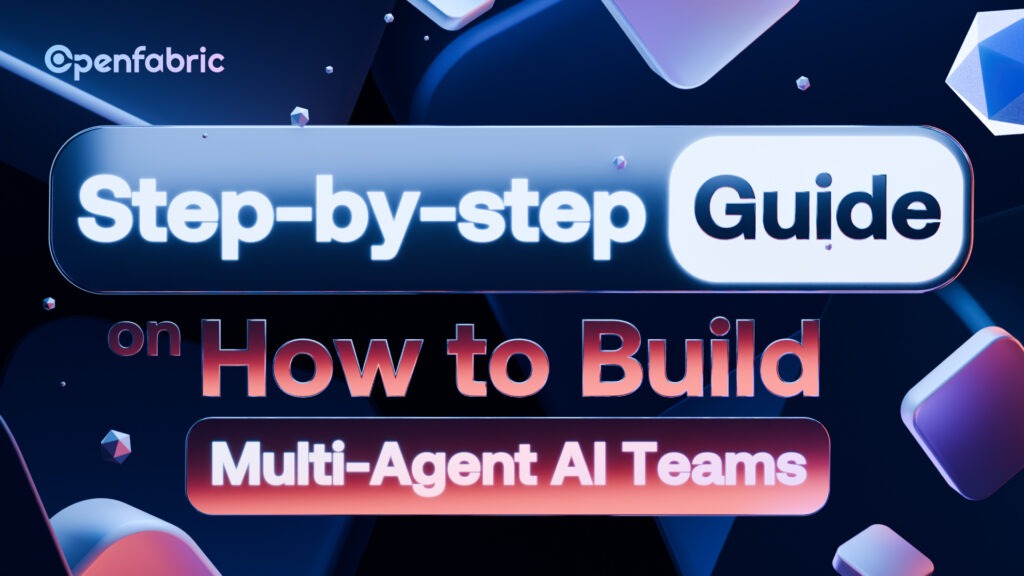
June 20, 2025 6 minutes read
Step-by-step Guide on How to Build Multi-Agent AI Teams

Many startups in the industry have begun to shift their focus towards AI agents. So much so that, nowadays, AI agents have become a mainstay in how we operate and carry out various activities. Innovation and creativity have also played a major role in the advancement of AI agents. For instance, you see a problem and you think to yourself, “How can I build an AI agent to solve this problem?”. That is how we have most of the AI agents we use today. However, when you look at the details, you will find that most of the functions of AI agents are not carried out by a single AI agent. It involves multiple AI agents in a team or system with each intelligent agent carrying out a specific function. The functionality of these systems relies entirely on how well the individual agents perform alone and synergistically. This leaves us with one question, how does one build multi-agent AI teams that perform well?
Earlier, building multi-agent AI teams was usually a highly industrial process that required many lines of code, took hours, and took a lot of manpower. Nowadays, it is easier and if you are not doing this yet or working towards it, you may be left behind. Fortunately, it’s not all bad because in this article we will see the steps to building a multi-agent AI team and tell you all you need to know about it.
Let’s get started!
What are multi-agent AI teams?
Before we go on to see how to build multi-agent AI teams, we need to understand what they are and what they can do. This is important because for us to know where and how to start we must have a picture of what we want to achieve.
Multi-agent AI teams include AI agents that can sense, learn, and act autonomously to achieve individual and collective goals. As stated earlier, each of these agents has a responsibility individually. However, they also work as a team to make autonomous decisions and act upon them. They interact with each other to solve complex tasks which cannot be achieved by a single agent. For example, one could develop an artificial intelligence system focused on creating vacation itineraries, booking flights, making hotel reservations, and so on. The separate agents in this AI system can then work together, share information, and divide the task in a personalized manner.
What are the benefits of multi-agent AI teams?
Multi-agent AI teams can be fully functional in any setting provided they are developed to handle the responsibilities. As such, some of the key benefits of multi-agent AI teams include:
Flexibility and scalability
Multi-agent AI teams have the ability to sense, learn, act autonomously, and adapt to their environment. This capability makes them highly flexible in any setting as they can quickly modify, add, or even remove any AI agent to adapt to changing environments. This also makes them highly scalable for solving complex problems.
Highly accurate
There is a popular African saying, “It takes a community to raise a proper child”. In this instance, it takes multiple AI agents interacting with one another to solve problems accurately. There are two things involved here;
The individual AI agents can concentrate on one aspect of the problem, reducing the complexity.
AI agents with errors can be easily identified, removed, and replaced.
A combination of both factors produces a multi-agent system that is well coordinated in its decision-making, and conflict resolution processes. This produces highly accurate and reliable results.
Robustness and reliability
The future of AI is decentralization, and multi-agent AI is a representation of how a decentralized AI system works. In multi-agent AI, the system is decentralized in that no single AI agent controls the operations of the entire system. This ensures the system works even when a few components fail and makes it reliable. In a centralized system, on the other hand, failure of the main component brings the entire system crashing down. The effect of such a single point of failure was seen recently when users experienced major setbacks due to the failure of centralized AI systems.
Faster problem solving
Multi-agent AI systems solve tasks much faster than single AI systems. This is because various parts of the task are distributed and solved by individual AI agents. They then communicate with each other and put everything together as the solution to complex problems.
How to build multi-agent AI teams?
Now that we have a clear understanding of what functional multi-agent AI teams are, we know how and what we want ours to do. Here is a step-by-step guide on how to build a functional multi-AI agent team.
Identify the goals and scope of the team.
What do you want your AI agents to solve? That is a very important question that must be answered before any work is done in the development of a multi-agent AI team. Define the objectives and outcomes you want to achieve. Thereafter, map out the different tasks and workflows that are required for this to work.
Create and train agents.
At first, this sounds like jumping the gun, but it is not. Nowadays, you don’t require long lines of code to create an AI agent. All you need is the right platform and set of instructions and you are good to go. Finding the right platform might come as a challenge except that it is not. Openfabric AI solves this problem by giving you a decentralized platform to create and train AI agents. It gets easier!
With Openfabric AI you do not have to go through the tedious task of creating AI agents from scratch unless you want to, otherwise, you can just use the pre-built agents that are available.
After creating the agents, you can train them in specific domains and give them specialized skills.
Define agent interaction
A multi-agent AI team is not a team unless the individual AI agents can communicate with each other and work together. When you build multi-agent AI teams that fail to do this, it may lead to undesirable outcomes, leaving you with a pile of wasted resources.
In a decentralized multi-agent AI team, the interaction between individual AI agents relies on communication protocols. They establish essential rules and frameworks that govern how AI agents share information and interact with each other. These protocols ensure that the AI agents share data efficiently while maintaining uniformity and accuracy across the system. They include
- Exchange protocol: governs the exchange of goods or services between agents
- Storage protocol: determines how agents store and retrieve data
- FIPA ACL: it is the standardized communication language. It serves as a framework for agent communication.
- Representational State Transfer API (RESTful APIs): govern agents’ interaction across the internet.
- Simple Object Access Protocol (SOAP): for secure, encrypted communication between private agents.
- MQTT: This is a lightweight messaging protocol. It allows data to be transmitted with minimal problems.
These protocols determine how the team functions. As such, factors such as security and data privacy, and the main aim of the multi-agent AI team must be considered before choosing a communication protocol.
Deploy and monitor
The last step is to deploy your multi-agent AI team and see how it functions. Like any new technology, you must closely monitor your new multi-agent AI team and adjust agents as necessary.
Conclusion
Everybody can be an AI developer. However, to be a good one, you must know how to build multi-agent AI teams that work efficiently. If you see a problem somewhere that AI can fix, define your objectives and goals, then head on to Openfabric AI where the user-friendly interface makes it seamless for anyone to create and train AI agents. Put these agents together into a team, then deploy this team to solve the problem you identified.
As AI agents continue to sense, learn, and adapt, multi-agent AI teams will drive AI deeper into the complex problems of every organization, regardless of size. Therefore, we can see a future where AI has a bigger impact on organizations than we have today!
Congratulations on building your multi-agent AI team!

